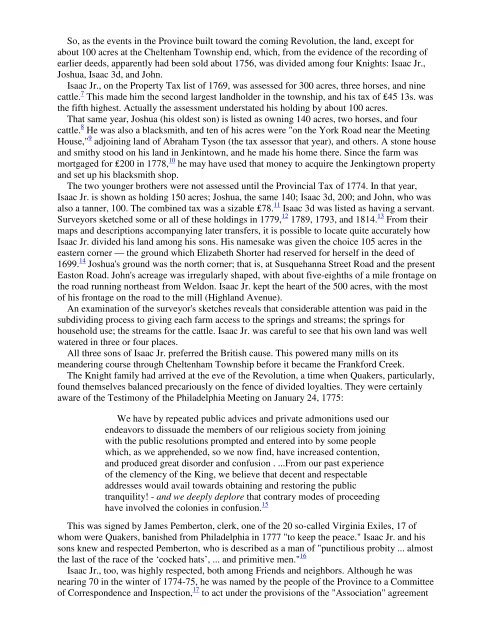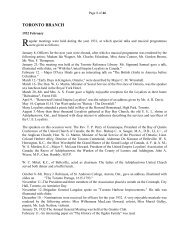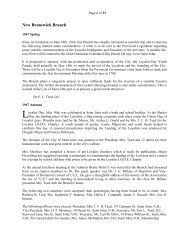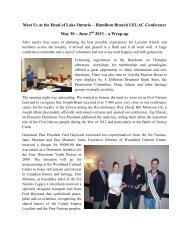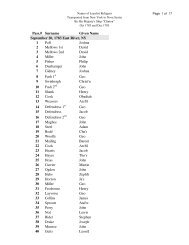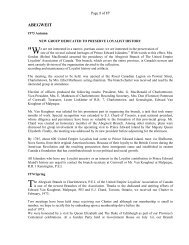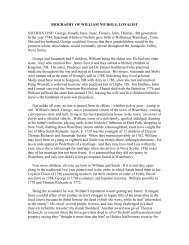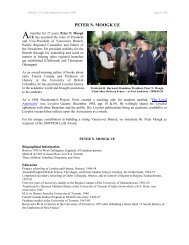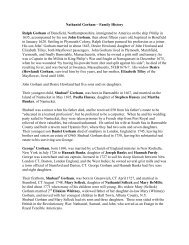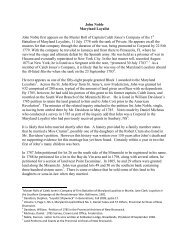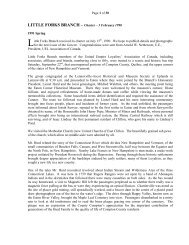Treason In Abington - for United Empire Loyalists
Treason In Abington - for United Empire Loyalists
Treason In Abington - for United Empire Loyalists
You also want an ePaper? Increase the reach of your titles
YUMPU automatically turns print PDFs into web optimized ePapers that Google loves.
So, as the events in the Province built toward the coming Revolution, the land, except <strong>for</strong><br />
about 100 acres at the Cheltenham Township end, which, from the evidence of the recording of<br />
earlier deeds, apparently had been sold about 1756, was divided among four Knights: Isaac Jr.,<br />
Joshua, Isaac 3d, and John.<br />
Isaac Jr., on the Property Tax list of 1769, was assessed <strong>for</strong> 300 acres, three horses, and nine<br />
cattle. 7 This made him the second largest landholder in the township, and his tax of ₤45 13s. was<br />
the fifth highest. Actually the assessment understated his holding by about 100 acres.<br />
That same year, Joshua (his oldest son) is listed as owning 140 acres, two horses, and four<br />
cattle. 8 He was also a blacksmith, and ten of his acres were "on the York Road near the Meeting<br />
House," 9 adjoining land of Abraham Tyson (the tax assessor that year), and others. A stone house<br />
and smithy stood on his land in Jenkintown, and he made his home there. Since the farm was<br />
mortgaged <strong>for</strong> ₤200 in 1778, 10 he may have used that money to acquire the Jenkingtown property<br />
and set up his blacksmith shop.<br />
The two younger brothers were not assessed until the Provincial Tax of 1774. <strong>In</strong> that year,<br />
Isaac Jr. is shown as holding 150 acres; Joshua, the same 140; Isaac 3d, 200; and John, who was<br />
also a tanner, 100. The combined tax was a sizable ₤78. 11 Isaac 3d was listed as having a servant.<br />
Surveyors sketched some or all of these holdings in 1779, 12 1789, 1793, and 1814. 13 From their<br />
maps and descriptions accompanying later transfers, it is possible to locate quite accurately how<br />
Isaac Jr. divided his land among his sons. His namesake was given the choice 105 acres in the<br />
eastern corner — the ground which Elizabeth Shorter had reserved <strong>for</strong> herself in the deed of<br />
1699. 14 Joshua's ground was the north corner; that is, at Susquehanna Street Road and the present<br />
Easton Road. John's acreage was irregularly shaped, with about five-eighths of a mile frontage on<br />
the road running northeast from Weldon. Isaac Jr. kept the heart of the 500 acres, with the most<br />
of his frontage on the road to the mill (Highland Avenue).<br />
An examination of the surveyor's sketches reveals that considerable attention was paid in the<br />
subdividing process to giving each farm access to the springs and streams; the springs <strong>for</strong><br />
household use; the streams <strong>for</strong> the cattle. Isaac Jr. was careful to see that his own land was well<br />
watered in three or four places.<br />
All three sons of Isaac Jr. preferred the British cause. This powered many mills on its<br />
meandering course through Cheltenham Township be<strong>for</strong>e it became the Frank<strong>for</strong>d Creek.<br />
The Knight family had arrived at the eve of the Revolution, a time when Quakers, particularly,<br />
found themselves balanced precariously on the fence of divided loyalties. They were certainly<br />
aware of the Testimony of the Philadelphia Meeting on January 24, 1775:<br />
We have by repeated public advices and private admonitions used our<br />
endeavors to dissuade the members of our religious society from joining<br />
with the public resolutions prompted and entered into by some people<br />
which, as we apprehended, so we now find, have increased contention,<br />
and produced great disorder and confusion . ...From our past experience<br />
of the clemency of the King, we believe that decent and respectable<br />
addresses would avail towards obtaining and restoring the public<br />
tranquility! - and we deeply deplore that contrary modes of proceeding<br />
have involved the colonies in confusion. 15<br />
This was signed by James Pemberton, clerk, one of the 20 so-called Virginia Exiles, 17 of<br />
whom were Quakers, banished from Philadelphia in 1777 "to keep the peace." Isaac Jr. and his<br />
sons knew and respected Pemberton, who is described as a man of "punctilious probity ... almost<br />
the last of the race of the ‘cocked hats’, ... and primitive men." 16<br />
Isaac Jr., too, was highly respected, both among Friends and neighbors. Although he was<br />
nearing 70 in the winter of 1774-75, he was named by the people of the Province to a Committee<br />
of Correspondence and <strong>In</strong>spection, 17 to act under the provisions of the "Association" agreement


